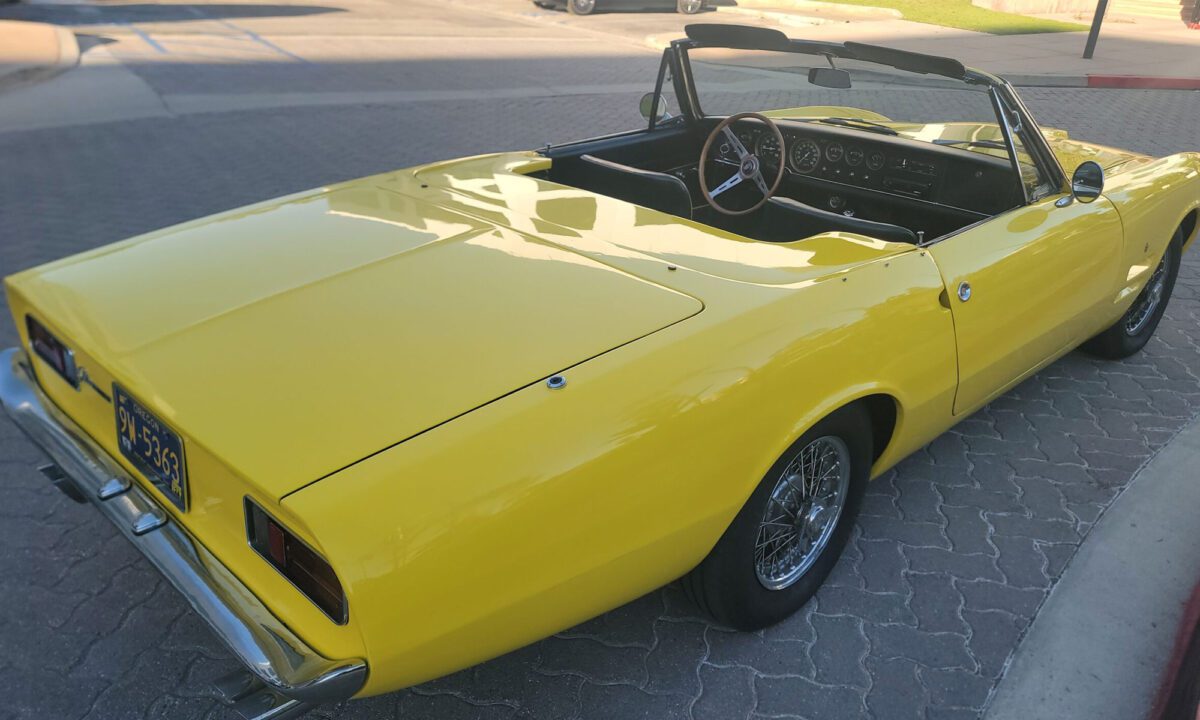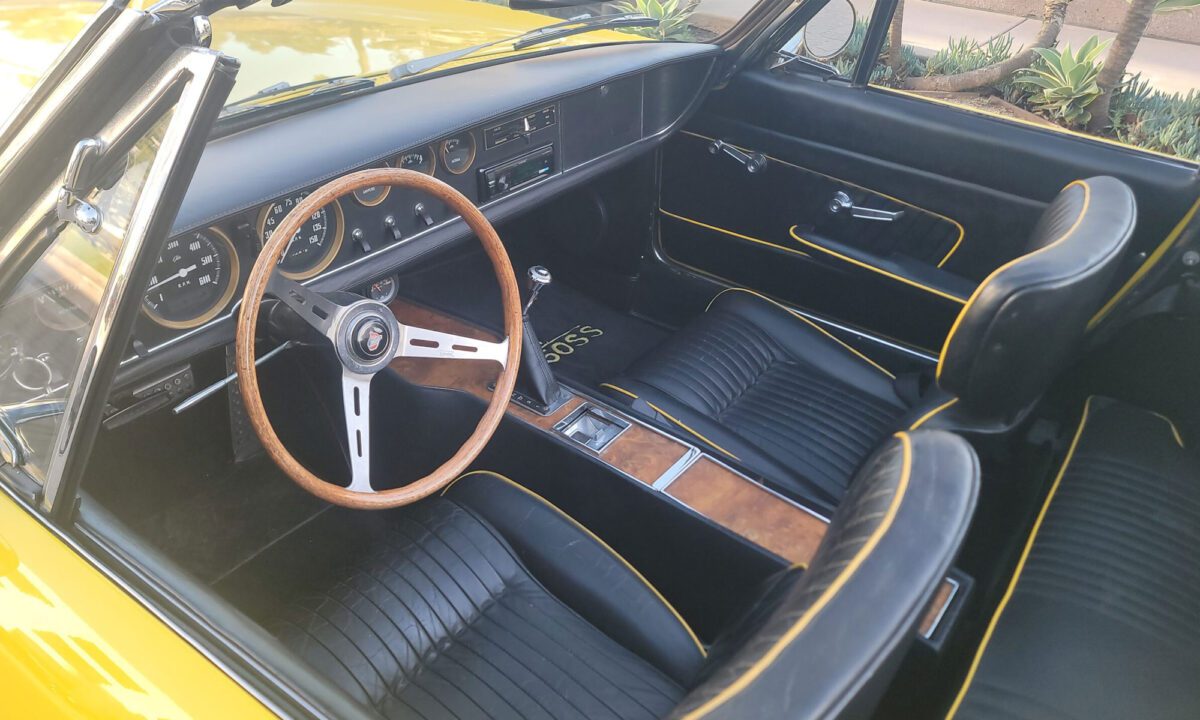Fiat concepts, celebrity producers, and a Plymouth Barracuda
At the 1963 Turin Auto Show, the Ghia G230 S was set on display. Based on the Fiat 2300, the G230 S used a specially designed and constructed tubular spaceframe. Two convertibles and two coupes were built, but sadly, the car never reached production.
Hollywood television and film producer, Burt Sugarman, saw the G230 S on the cover of Road & Track magazine and contacted his friend, John DeLorean, at General Motors asking for help to get the G230 S into production. While DeLorean wasn’t able to do anything directly, he did meet with Sugarman in Detroit to introduce him to Bob Anderson, the general manager at Plymouth. Chrysler had a lengthy history in building cars with Ghia, and DeLorean felt there would be good synergy between Ghia, Sugarman, and Anderson.
Sugarman convinced Anderson to send 50 to 100 Barracuda chassis and drivetrains to Ghia, upon which they could set the body and interior of the G230 S and create a working, sellable car. Anderson loved the idea, but took it a step further, installing an Italian-speaking Chrysler engineer at Ghia, sending a Barracuda, and working with the Italians to create a remarkable two-seater roadster upon the Barracuda’s otherwise simple chassis. To make it all work, a ladder frame was created and the body was widened. The result was the Ghia 450 SS – the 450 denotes the Chrysler 4.5L V-8 engine. Easily serviceable in North America, Chrysler honored the warranty at any dealership – the car should have filled a gap south of the pricing of a Ferrari or Maserati, but north of the Porsche 911 and Chevrolet Corvette. As is often the case with a specialty, joint-production vehicle, the Ghia 450 SS saw a few delays and developmental difficulties which drove the price upward into the Ferrari-Maserati neighborhood. Needless to say, with a Chrysler-derived chassis and drivetrain, the sell was going to be more difficult. The hope was that buyers would appreciate the hand-built construction, voluptuous design, and ease of maintenance over the more exotic cars.
While all the engineering and planning was taking place, Sugarman set up a dealership in Beverly Hills, California on Wilshire Boulevard. He also became a distributor for the Excalibur neo-classic automobiles, which initially gave the dealership something to sell as they were readily available. In Europe, Ghia established a sales network as well – the first cars arrived in Beverly Hills in 1966. Despite efforts promoting the cars through popular magazines and word-of-mouth spreading in one of the world’s wealthiest cities, Beverly Hills, the 450 SS sold very slowly. Production ended in the middle of 1967, with just 57 cars produced. Today, it’s believed that just 37 remain in existence between the USA and Europe.

What is Ghia?
The Ghia name stretches back to 1916, when Giacinto Ghia entered business to design and build specialty-body cars, in particular concept cars and cars requiring special materials, especially aluminum. The company’s work has been seen on a multitude of cars, most popularly Fiat, Alfa Romeo, and Lancia, and was involved in the production of a number of joint Chrysler-Ghia production cars in the 1950s and 1960s. Interestingly, the Volkswagen Karmann-Ghia was styled by Ghia to resemble the Chrysler Ghia d’Elegance. Despite a lengthy, successful, and colorful relationship with the Chrysler Corporation, an association was forged between Ford and Ghia via Alejandro DeTomaso. Ford supplied a multitude of components for the DeTomaso Pantera, which Ghia styled. Ghia would become part of the Ford empire in 1973, and remains part of the Ford portfolio today.

What cars has Ghia produced?
Ghia has had its hand on a huge variety of cars, but some of the more popular cars bearing the company’s name include the seemingly infamous 1957 Dual-Ghia, the 1958 Renault Caravelle, the 1961 Ghia L6.4, the 1963 Chrysler Turbine Car, and the 1971 DeTomaso Pantera. When Ford acquired Ghia in 1973, one of the first orders of business was to have the styling and design company work their magic on a variety of cars ranging from the Granada to the all-new-for-1974 Mustang II among a string of concept cars.
Is a Ghia worth buying?
In a word, yes. Every specialty Ghia car, meaning not for mass production, such as the 450 SS, the L6.4, the Dual-Ghia, and so on have gained value steadily over the years. While the market is fairly narrow, the trend since about 2005 has seen an increased interest in these unique specialty cars. All of them were wholly expensive when they were new and can largely be considered works of art. Case in point, the DeTomoso Pantera, which was styled by Tom Tjaarda while working for Ghia, has seen exponential monetary value gains over the years, many of them crossing the $100,000 mark – during the 1980s and ’90s, most of these cars in excellent condition hovered in the $30,000 range, showing only limited signs of increasing. Times have changed. As such, many of the design house cars, Ghia, Pininfarina, and Bertone among them, have enjoyed exponential value increases. Cars like the 450 SS are edging near the $200,000 mark, a figure we would expect to see in the next five to 10 years for them.
Photo Credit: Stuart Stickley